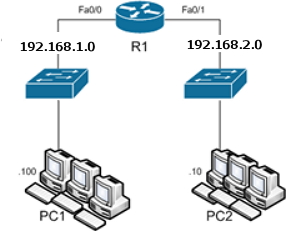As you start to prepare for your Cisco CCENT 100-101 or CCNA exam 200-120, the most important thing you will need to know is what is a router and what do they do. So as a part of our CCNA Test Question of the Day, we are going to look at Cisco routers and what they do. The format will be a little different today, so just follow along and all will be good! First read today’s test question of the day and then write down your answer without reading further.
What is the purpose of a router?
A. to interconnect networks and choose the best paths between them
B. to provide the connection points for the media
C. to serve as the end point in the network, sending and receiving data.
D. to provide the means by which the signals are transmitted from one networked device to another.
So let’s at a high level refresh our memories with some CCNA or CCENT theory on routers and their functions and maybe compare them to hubs and switches. I am sure you remember that hubs let all traffic pass through them and do not do any type of data management. Switches introduce some traffic management in that switches break up collision domains on the network so you have a more efficient network. Routers break up broadcast domains so you are not sending broadcast traffic across the network for no reason that every host has to process. So is this CCNA theory coming back to you?
We will use a couple of network diagrams to help illustrate what a router does and compare each and how they are used in the real world. This will really help prepare you for Cisco’s new CCENT or CCNA exam as you will see these types of questions on the ICND1, ICND2, or CCNA exam.

But before we start, I want to explain some of the common network diagram symbols and what they mean. The round device with two arrows pointing in and two arrows pointing out is a router. The blue square device with four arrows pointing out is a switch. These are the same type of topology diagrams you will see on your CCENT or CCNA exam. So you want to get used to them early in your Cisco certification studies and they will become second nature to you.
In our first diagram above, you will see a single PC connected to the FastEthernet port on a router. Now you may not be aware of this early in your CCNA studies, but routers generally do not come with a lot of Ethernet ports. Why? Well their job is to break up broadcast domains and route data between different subnets. Thus an entire subnet should be connected to the FastEthernet port. As if you have two FastEthernet ports on the router, one may be for subnet 192.168.1.0 and the other for 192.168.2.0. We do not want the broadcasts going from the 192.168.1.0 network over to the 192.168.2.0 network. The router will stop that and keep the broadcasts from propagating. But at the same time, it will figure out how to route data from the 192.168.1.0 subnet to the 192.168.2.0 subnet based upon the data that is in its route tables. Wow, that was a mouthful for this early in your CCNA and CCENT studies, huh?
Ok, so stick with me and you will see how this would look in the real world and not just on your CCNA exam. Remember that we said above that routers do not normally come with a bunch of FastEthernet ports and that is because their job is to route data between networks. So our next topology diagram below we see how you will generally have a switch hanging off of a router’s FastEthernet interface and that switch can have 24, 48, or even hundreds of switch ports. Does this diagram make more sense now?

So in a perfect world of a properly designed network, 80% of your traffic will stay on the PCs just hitting the switches and staying on that local subnet. Then 2o% of your traffic will have to route across the router. Now with all that information, let’s see what the correct answer was so you will be prepared for your CCNA exam.
Correct CCNA Answer:
A. A network device that forwards packets from one network to another. Based on internal routing tables, routers read each incoming packet and decide how to forward it. The destination address in the packets determines which interface on the router outgoing packets are directed to.
Incorrect CCNA Answer:
B. A switch or hub is typically used to connect servers and workstations/PCs to the network.
C. A switch typically sits on the edge of the network (access layer) to connect user workstations/PCs.
D. Bits are sent from one network device to another. There are numerous devices that communicate with each other to send data (i.e. switch, router).
